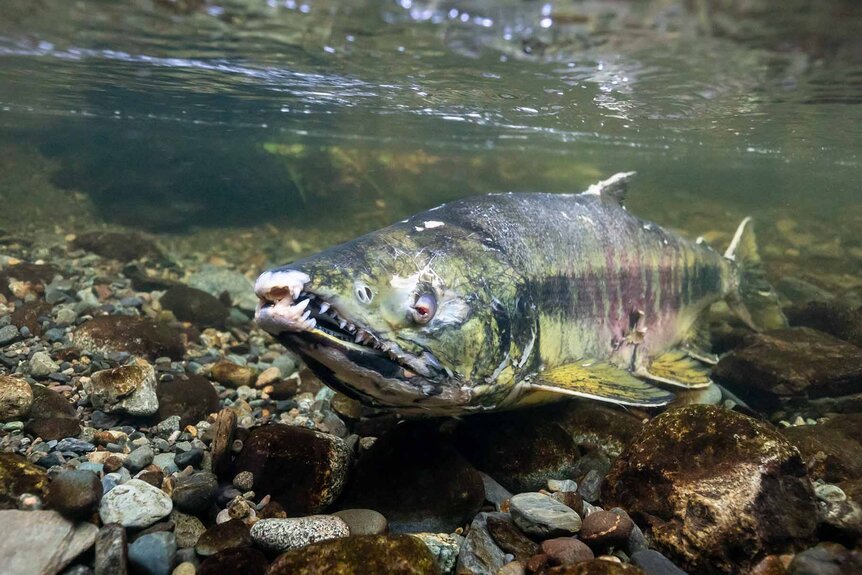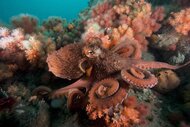The Americas Explores Zombie Fish at the Prince William Sound Salmon Migration
In The Americas you can get up close and personal with the romance and horror of salmon mating.
In The Americas, Tom Hanks takes us on an epic 10-part adventure through the natural world. The series covers the world’s largest supercontinent, stretching from the southern tip of Chile to the frigid upper reaches of Alaska. Years in the making, the result of hundreds of expeditions on both sides of the equator, The Americas reveals incredible natural stories happening all around us.
The first episode takes us to the frozen north, a land filled with webbed-footed hares, deadly avalanches, and some of the most impressive migrations on land and sea. Perhaps the most bizarre among them is the bi-yearly migration of pink salmon, which transforms still-living fish into the swimming dead at Alaska’s Prince William Sound.
Shooting fish in a barrel, how filmmakers captured an Alaskan salmon run
“There’s a hundred stories or more in [The Americas] and this is one of my absolutely favorite stories,” The Americas executive producer Mike Gunton told NBC Insider. “They’re called zombie salmon.”
RELATED: The Americas Narrator Tom Hanks is Full of Nature Facts: "I'm the Greatest Dinner Companion"
Salmon begin their lives in the relatively quiet waters of upstream rivers. After hatching, they make their way downstream to the ocean, where they mature and grow. Two years later, they return to the entrance of the very same river, determined to return home and spawn. An estimated 200 million pink salmon begin the journey, like racers at the starting block, they wait to begin a race which is equal parts marathon and deadly gauntlet.
As the tide goes out, the scent of their spawning ground strengthens, and they take off like millions of half-submerged rockets. Each fish is carrying the genetic material which will make up the next generation of salmon, and they have to cover the distance, fighting the tide and an army of predators the whole way. They can barely breathe, can hardly move, but they must continue onward. On the upside, the relative difficulty of their task made things easier for the documentary team.
“One thing in your favor is they can’t go anywhere. They’re locked into that river, and you know they’re going from the mouth to the top, so you can stake it out,” Gunton said. “Also, when animals are on an absolute mission, which of course those salmon are, they tend to be a bit less concerned about a camera man walking up and putting a tripod in the ground. At other times, they’d be off like a shot.”
What happens to the zombie salmon?
Surviving to adulthood and getting to the river mouth are only the beginning. Throughout their upstream journey, their bodies begin to shut down. They hardly eat or rest, moving constantly against the current toward their spawning ground. Even if they survive the onslaught of birds and bears, their bodies might shut down before they get where they’re going.
RELATED: Tom Hanks Reveals He was Awed by The Americas Footage: "How Is That Even Possible?!"
"As you can imagine, there are thousands upon thousands of salmon and thousands of miniature little dramas going on all the time. You can be a bit like a kid in a toyshop,” Gunton said. “What we try to do is not stories generically about salmon, but stories about an individual.”
What they saw and documented was equal parts romance and horror.
Throughout the spawning process, salmon go through a system-wide transformation, turning them from creatures with complex behavior into a biological machine with a single purpose: to reproduce. Pigments in their muscles move to the surface, turning their ordinarily silver skin a lush pink. Their fat stores begin to burn up as females grow their eggs and males develop massive teeth and a hooked upper jaws for fighting. The cardiovascular system starts to shut down, muscles decay, the stomach contracts, intestines atrophy, and the other organs slow and stop.
The results aren’t pretty. By the time they reach the spawning grounds, some of the salmon are in an advanced state of decay, their eyes falling out and their flesh sloughing off. By all accounts they should be dead, yet they continue on. These swimming corpses have just a single goal, to mate before they die for real.
Of course, being half alive isn’t a great way to make a good first impression and female salmon can be picky. Males will mate as many times as they can manage, but females release their eggs just once. When the job is done, they die en masse, their bodies enriching the environment and setting the stage for their descendants, who are destined to repeat the process all over again.
Where to watch The Americas
The Americas debuts with a special two-part premiere on Sunday February 23, at 7:00 p.m. ET. Viewers will be treated to a documentary double feature, including episode one “The Frozen North” and episode two “The West Coast.”
The premiere will air simultaneously on NBC, Bravo, CNBC, E!, SYFY, and USA. After the premiere, episodes will air weekly on Sundays at 8:00 pm ET, and will be streaming on Peacock the following day!




















